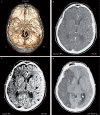Letter to the Editor. CT angiography source-images and CT perfusion: are they complementary tools for ischemic stroke evaluation? Response to: reliability of CT perfusion in the evaluation of ischaemic penumbra
- PMID: 24976206
- PMCID: PMC4202902
- DOI: 10.15274/NRJ-2014-10043
Letter to the Editor. CT angiography source-images and CT perfusion: are they complementary tools for ischemic stroke evaluation? Response to: reliability of CT perfusion in the evaluation of ischaemic penumbra
Keywords: CT angiography; CT perfusion; source-images ischemic stroke.
Figures

Comment in
-
Response to letter to the editor. "CT angiography source-images and CT perfusion: are they complementary tools for ischemic stroke evaluation?".Neuroradiol J. 2014 Jun;27(3):368. doi: 10.15274/NRJ-2014-10044. Epub 2014 Jun 17. Neuroradiol J. 2014. PMID: 24976207 Free PMC article. No abstract available.
Comment on
-
Reliability of CT perfusion in the evaluation of the ischaemic penumbra.Neuroradiol J. 2014 Feb;27(1):91-5. doi: 10.15274/NRJ-2014-10010. Epub 2014 Feb 24. Neuroradiol J. 2014. PMID: 24571838 Free PMC article.
Similar articles
-
Response to letter to the editor. "CT angiography source-images and CT perfusion: are they complementary tools for ischemic stroke evaluation?".Neuroradiol J. 2014 Jun;27(3):368. doi: 10.15274/NRJ-2014-10044. Epub 2014 Jun 17. Neuroradiol J. 2014. PMID: 24976207 Free PMC article. No abstract available.
-
Reliability of CT perfusion in the evaluation of the ischaemic penumbra.Neuroradiol J. 2014 Feb;27(1):91-5. doi: 10.15274/NRJ-2014-10010. Epub 2014 Feb 24. Neuroradiol J. 2014. PMID: 24571838 Free PMC article.
-
Reliability of visual assessment of non-contrast CT, CT angiography source images and CT perfusion in patients with suspected ischemic stroke.PLoS One. 2013 Oct 8;8(10):e75615. doi: 10.1371/journal.pone.0075615. eCollection 2013. PLoS One. 2013. PMID: 24116061 Free PMC article.
-
Computed Tomography, Computed Tomography Angiography, and Perfusion Computed Tomography Evaluation of Acute Ischemic Stroke.Neuroimaging Clin N Am. 2018 Nov;28(4):565-572. doi: 10.1016/j.nic.2018.06.002. Epub 2018 Sep 15. Neuroimaging Clin N Am. 2018. PMID: 30322593 Review.
-
Perfusion Computed Tomography for the Evaluation of Acute Ischemic Stroke: Strengths and Pitfalls.Stroke. 2016 Apr;47(4):1153-8. doi: 10.1161/STROKEAHA.116.011873. Epub 2016 Mar 10. Stroke. 2016. PMID: 26965849 Review. No abstract available.
References
-
- Alves JE, Carneiro A, Xavier J. Reliability of CT perfusion in the evaluation of the ischaemic penumbra. Neuroradiol J. 2014;27(1):91–95. doi: 10.15274/NRJ-2014-10010. - DOI - PMC - PubMed
-
- Schramm P, Schellinger PD, Fiebach JB, et al. Comparison of CT and CT angiography source images with diffusion-weighted imaging in patients with acute stroke within 6 hours after onset. Stroke. 2002;33(10):2426–2432. doi: 10.1161/01.STR.0000032244.03134.37. - DOI - PubMed
-
- Lin K, Rapalino O, Law M, et al. Accuracy of the Alberta Stroke Program Early CT Score during the first 3 hours of middle cerebral artery stroke: comparison of noncontrast CT, CT angiography source images, and CT perfusion. Am J Neuroradiol. 2008;9(5):931–936. doi: 10.3174/ajnr.A0975. - DOI - PMC - PubMed
-
- Kamalian S, Kamalian S, Maas MB, et al. CT cerebral blood flow maps optimally correlate with admission diffusion-weighted imaging in acute stroke but thresholds vary by postprocessing platform. Stroke. 2011;42(7):1923–1928. doi: 10.1161/STROKEAHA.110.610618. - DOI - PMC - PubMed
Publication types
MeSH terms
LinkOut - more resources
Full Text Sources
Other Literature Sources
Medical

